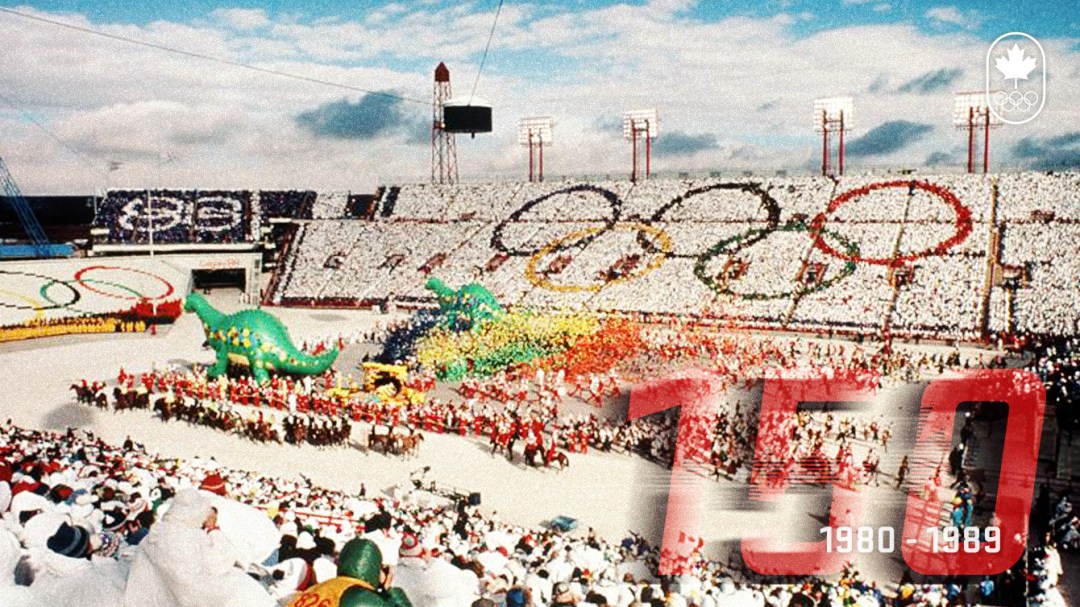150 years of Canadian sport: the 1980s
In less than a month, the entire country will celebrate Canada’s 150th birthday.
Of course, Olympic.ca is well into its celebration with our decade by decade look at great moments in Canadian sport. To remind yourself of what came before, simply click here.
Or continue on and join us in the 1980s for some more stories of incredible sporting success.
1980 – Podborski Puts North America on Men’s Olympic Downhill Podium
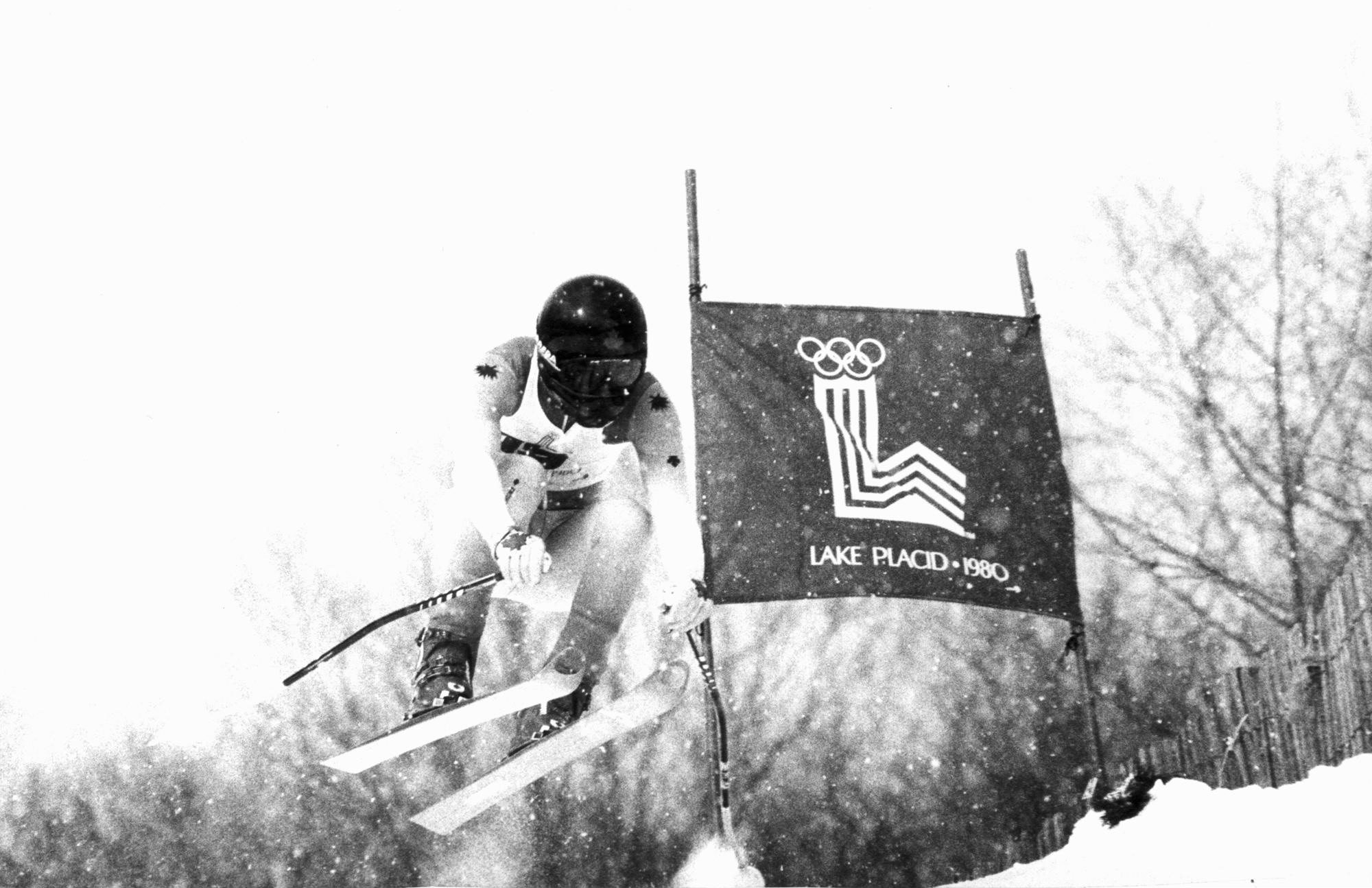
Canadian skier Steve Podborski is in the air while he speeds down the Whiteface Mountain race course on his way to win an Olympic bronze medal, clocking time 1.46.62, Feb. 14, 1980 (CP PHOTO/ AP)
One of the “Crazy Canucks” – the group of Canadian alpine skiers best known for their aggressive and seemingly reckless style of skiing – Steve Podborski was the only member to win an Olympic medal. When he took bronze in the downhill at Lake Placid 1980, he became not only the first Canadian man to win an Olympic medal in alpine skiing, but also the first non-European man to stand on an Olympic downhill podium. Podborski would follow that success in 1981-82 by becoming the first North American man to win the overall World Cup title in the downhill and the first Canadian man to win any Crystal Globe. When he retired in 1984, he did so with eight career World Cup victories, the most by any Canadian male alpine skier.
1980 – Marathon of Hope
It was on April 12, 1980 in St. Johns, Newfoundland, that Terry Fox dipped his prosthetic leg into the frigid waters of the Atlantic Ocean to begin his Marathon of Hope. Each day, he travelled an average of 40km – about the distance of a marathon – through ice storms, bitter winds, and summer heat to raise funds for cancer research. As his cross-country trek continued, more and more Canadians began to rally behind him. After 143 days and more than 5300km, Fox made it to Thunder Bay, Ontario where it was discovered that his cancer had progressed from his legs to his lungs.
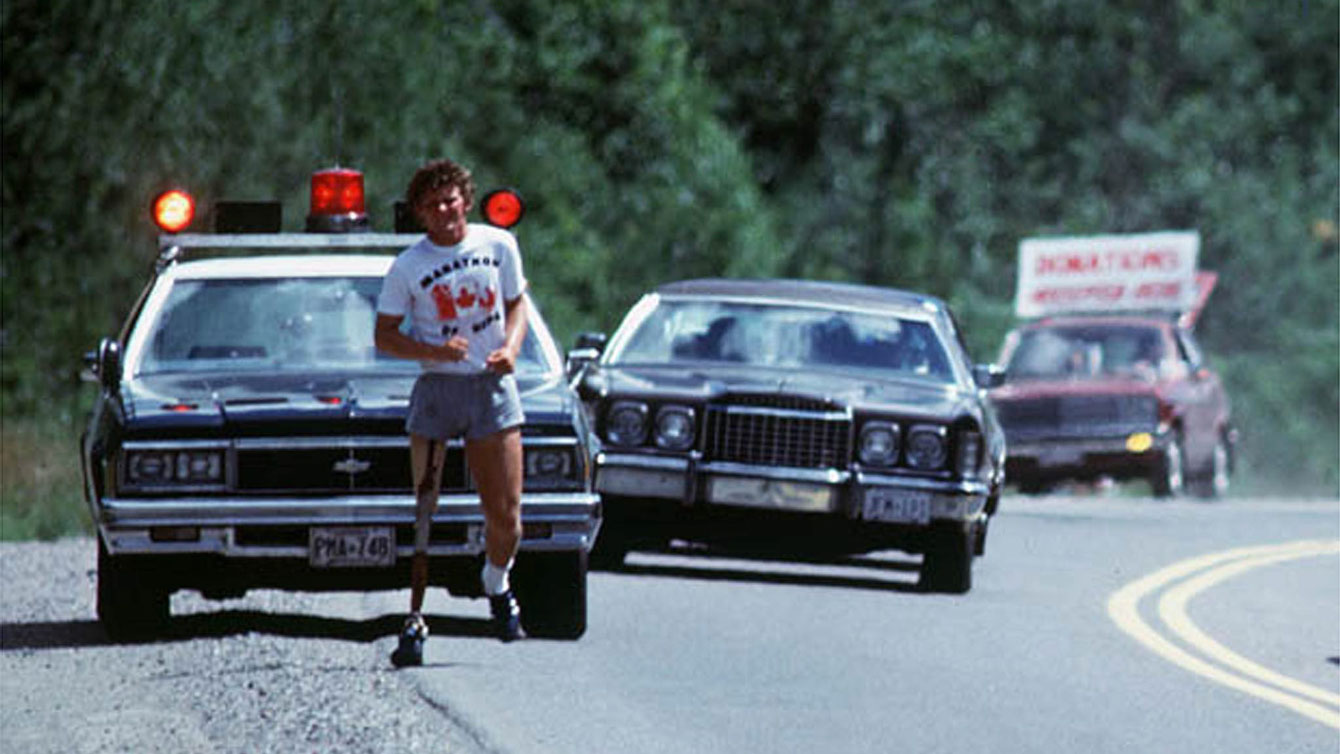
Terry Fox received Ontario Provincial Police escort while he ran through Ontario. In the photo, the third car in the convoy has a sign that reads “Donations Accepted Here.”
Having started with a goal of raising $1 million dollars, the response he received upped the goal to $1 for every Canadian for a total of $23 million, which was also surpassed by more than a million dollars. While he spent the next 10 months battling the disease, Fox was honoured with the Lou Marsh Award as Canada’s Athlete of the Year and became the youngest Companion of the Order of Canada. He passed away on June 28, 1981, one month before his 23rd birthday. But his legacy lives on through the annual Terry Fox Run which has raised more than $650 million dollars.
1984 – Boucher’s Gold Medal Breakthrough
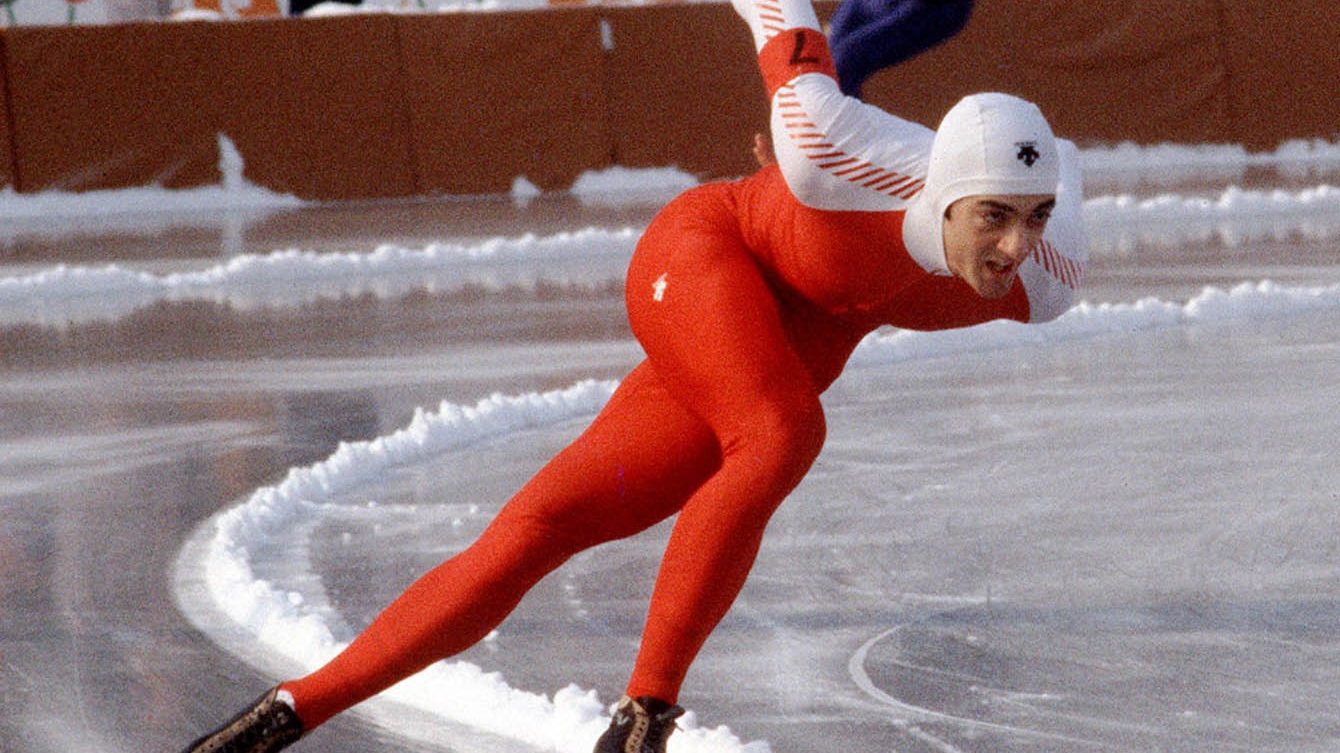
Canada’s Gaétan Boucher participates in a speed skating event at the 1984 Olympic Winter Games in Sarajevo. (CP PHOTO/COC/O. Bierwagon
Sixty years after the first Olympic Winter Games, Gaétan Boucher finally became the first Canadian man to win Olympic gold in an individual winter sport. The speed skater had won 1000m silver at Lake Placid 1980, but cemented his legacy four years later when he stood on the top step of the podium in the event. Two days later he added a second gold medal in the 1500m. Along with the 500m bronze he had won on the opening day of the speed skating competition in Sarajevo, he brought his career total to four medals which, at the time, made him Canada’s most decorated Winter Olympian. He was named 1984’s Lou Marsh Award winner.
1984 – Biggest Team and Brightest Lights at Los Angeles 1984
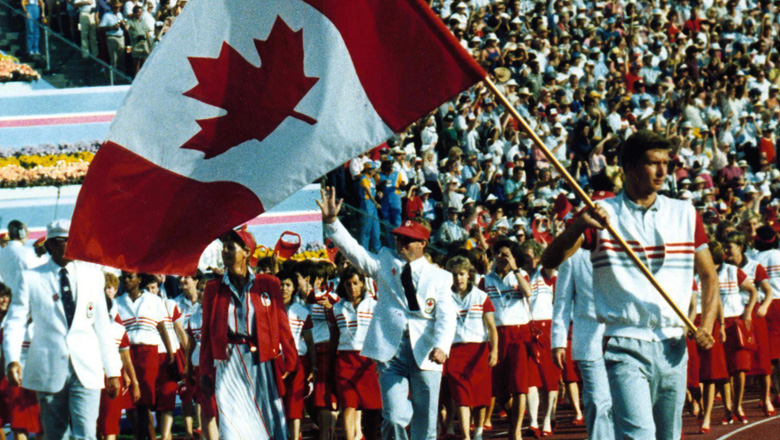
Alex Baumann leads Canada into the Los Angeles 1984 Opening Ceremony.
Canada sent its largest Olympic team ever to the 1984 Games in Los Angeles. The 436 athletes – 173 men and 163 women – came home with the country’s largest medal haul ever with 44, including 10 gold. Those numbers were certainly inflated due to the boycott by Soviet-bloc countries, but that doesn’t diminish the Canadian success stories.
Sylvie Bernier became the first – and so far only – Canadian diver to win Olympic gold with her first place finish in the 3m springboard.
Linda Thom became the first – and so far only – Canadian female shooter to win any Olympic medal when she captured gold in the 25m pistol.
Lori Fung became the first – and so far only – Canadian rhythmic gymnast to win any Olympic medal when she claimed the individual all-around gold medal.
1984 – Great Performances in the Olympic Pool
One of Canada’s most successful sports at Los Angeles 1984 was swimming. The 10 medals won were a single Games record for the country in the sport. Two of those medals were the golds won by Alex Baumann in the 200m and 400m individual medleys, both in world record times. He was that year’s winner of the Lionel Conacher Award as Canada’s Male Athlete of the Year.
Anne Ottenbrite and Victor Davis were both double medallists in the 100m and 200m breaststroke events as they each won gold in the longer distance and silver in the shorter. They also stood on the podium with their teammates in the 4x100m medley relay. Ottenbrite was Canada’s only female swimming gold medallist until Penny Oleksiak came along at Rio 2016. When Davis added a silver medal in the medley relay at Seoul 1988, he became Canada’s most decorated swimmer ever, also a mark matched by Oleksiak. Sadly, just a few months after his retirement in 1989, Davis was struck by a car and died two days later from his injuries.
1985-1987 – Man in Motion
On March 21, 1985, Rick Hansen set out on his around-the-world Man in Motion tour from Vancouver. He returned two years, two months and two days later, having raised $26 million towards realizing his dream of a truly accessible and inclusive world while increasing awareness of the potential of people with disabilities. In that time, he pushed his wheelchair through 34 countries on four continents, wheeling the equivalent of two marathons every day for a total of 40,075km. He averaged 30,000 strokes a day across all types of terrain in all types of weather while dealing with severe injuries to his shoulders, wrists and hands. Of the 792 days that he and his team were on the road, Hansen was wheeling on 465 of them.
1988 – Battle of the Brians
Calgary 1988, the first Olympic Winter Games to be held in Canada, featured one of the most anticipated showdowns in Olympic figure skating history. Brian Boitano, the American who had won the 1986 world title, versus Brian Orser, the Canadian who was the reigning world champion and the host nation’s flag bearer at the Opening Ceremony. After the compulsory figures and short program, they sat first and second with the knowledge that whoever won the free skate would win the gold medal. Boitano skated first, giving an almost perfect performance. Orser took to the ice last, making the minute errors of two-footing his triple flip landing and turning a planned triple Axel into a double. But that was likely the difference. Orser was given the outright nod by four judges while Boitano was preferred by three. However, the other two judges that had them tied gave Boitano the edge on the technical mark, which at the time was the tiebreaker to create a 5-4 split. The rules changed the next year to make the artistic mark the first tiebreaker, which would have given Orser the gold.
Orser’s silver was one of three figure skating medals won by Canada in Calgary. Elizabeth Manley broke up the Battle of the Carmens between East German Katarina Witt and American Debi Thomas, winning her own silver medal with the performance of her life after having been snubbed by prognosticators in the leadup. Tracy Wilson and Rob McCall captured bronze for Canada’s first ever Olympic medal in ice dance.
1988 – Browning Breaks Down Quad Barrier
It was the moment that really introduced Kurt Browning to the figure skating world at large. In just his second world championship appearance, Browning made history on March 25, 1988 when he landed the first ever quadruple jump in competition. Several men had tried and failed at it before, including Browning who fell on his attempt at Calgary 1988. The quad toe loop was the first jump planned in his free skate and it was ratified for having the required one foot landing. The successful element helped him to finish third in the free skate, a boost to his confidence that certainly helped as he went on to win four of the next five world titles. Nearly three decades later, quads have become ubiquitous in men’s figure skating, with all but the Axel having been landed, and competitors attempting up to six quads in their free skates.
1988 – Lemieux Saves Shipwrecked Competitors

Lawrence Lemieux at the Seoul 1988 Olympic Games (CP Photo/COC)
It is one of the greatest examples of Olympic sportsmanship. While the 470 and Finn class races were occurring simultaneously in Seoul, wind blowing 35 knots capsized the dinghy of two Singaporean sailors. Desperately clinging to their boat, they were in danger of being pulled out to sea by the strong current. But they were spotted by Canada’s Lawrence Lemieux, who at that point was running in second place in his Finn race. He abandoned his race to pull them from the water and stay with them until patrol boats arrived. As a reward for his act of “sportsmanship, self-sacrifice and courage”, he was awarded with a second place finish in that fifth of seven races, as well as the Pierre de Coubertin Award by IOC President Juan Antonio Samaranch.
1988 – Golden End to Seoul 1988
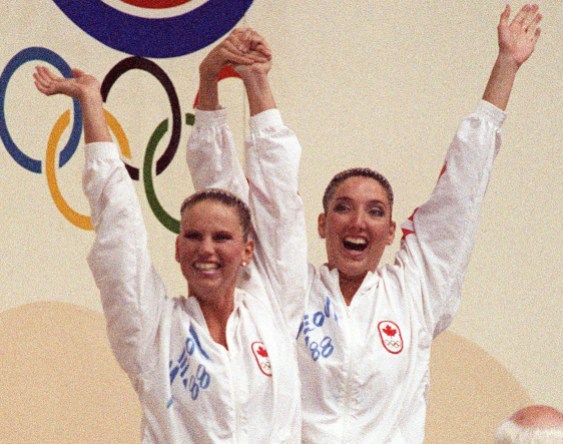
Canada won three gold medals at Seoul 1988, all coming in the closing days of the Games, allowing the country to end on a high note. On the third last day, Carolyn Waldo placed first in the solo synchronized swimming event, after building up an insurmountable lead in the preliminary figures. She also handily won the final to take the gold medal. The next day was the duet final, in which Waldo teamed with Michelle Cameron. They needed every bit of the lead they had established in the preliminary figures to claim gold.
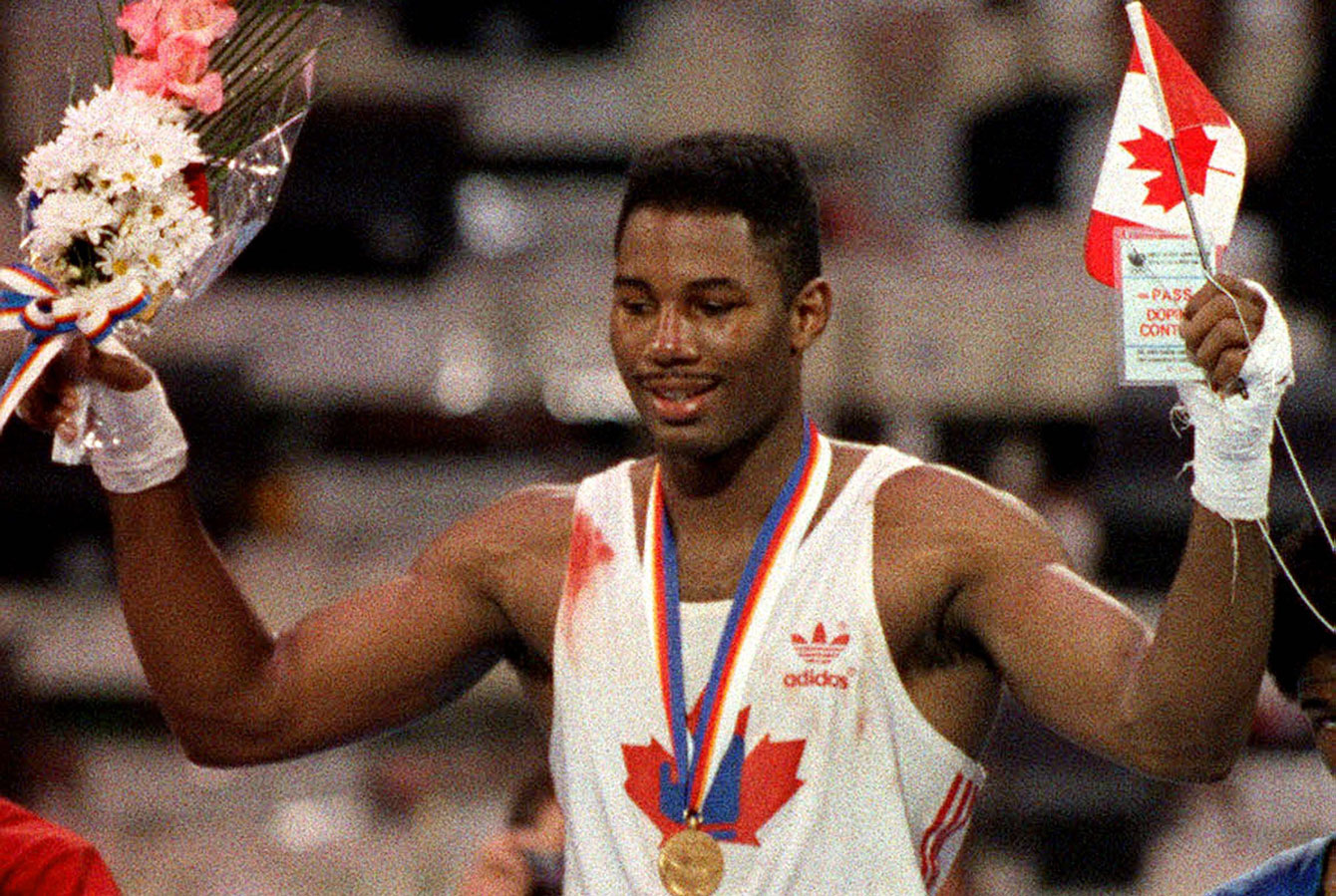
Lennox Lewis celebrates his Olympic gold medal at Seoul 1988.
The final day of the Games featured boxer Lennox Lewis in the super heavyweight final against American Riddick Bowe. After dropping the first round, Lewis became more aggressive and took control in the second round, forcing his opponent to take two standing counts. After the second, Bowe was set back to his corner as the referee waved the bout over, giving Canada its first boxing gold since Antwerp 1920.
1988 – Bauer Wears Yellow at Tour de France

Canada’s Steve Bauer competes in a cycling event at the Los Angeles 1984 Olympic Games. (CP PHOTO/ COC/ J Merrithew)
Four years after winning Canada’s first Olympic road cycling medal (silver in the road race), Steve Bauer made his mark in the world’s most famous cycling race – the Tour de France – becoming just the second Canadian to ever wear the yellow jersey. He won the first stage after the prologue and spent five days in the yellow jersey on his way to finishing fourth in the general classification. Two years later he would wear the yellow jersey for the first nine stages of the race. Bauer participated in 11 editions of the Tour de France from 1985 to 1995. It was also in 1988 that Bauer won world championship silver in the road race.

